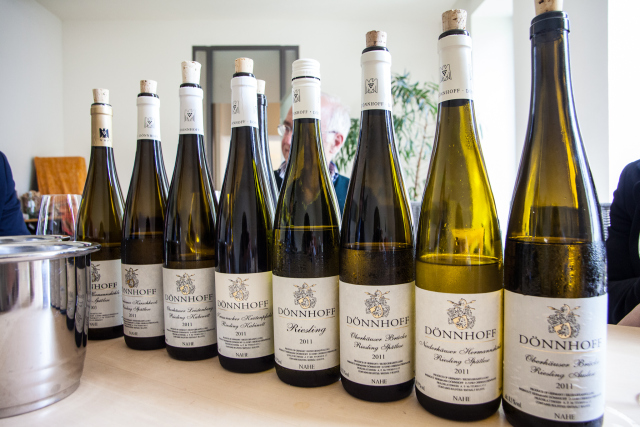Ignoring sherry for the moment (a nearly impossible sell I have discovered, although I persist in carrying ‘mid snow and ice a banner with this strange device) there is possibly some small stirrings of life in the German aisle of your local wine store.
Okay before we get to the wine here’s the hard part of the column – German wine classification. Tablewine is the lowest end of the spectrum. In ascending order you then have Qualitatswien, Qualitatswien mit Pradikatt (AKA QMP), Spatlese, Auslese, Beerenauslese, and Trockenbeerenauslese (AKA TBA). The last two are dessert wines and quite expensive. They also cellar for over 100 years.
To make matters worse the Germans have realized that this system does us auslanders no good what so ever, so they are re-packaging the wines to make them more accessible. However you still usually find the formal classification on the back label. (You should also find the appellation as well: Pfalz, Rheinhessen etc. These are geographic and unlikely to interest you until you’ve drunk way more German wine than I have; and I have 30 year start on you.)
You do need to know that Germans consider wines labeled as Spatlese and Auslese as table wines. (I’ve excluded them here.) If you are new to this category you may find both too sweet; although if your only wine experiments so far are Apothic and competitors you will find the wine quite enjoyable. Kabinett and Qualitatswein are the more common, less sweet levels. I would suggest most people will be happier if they buy those classes, at least at the beginning.
So why do people like sommeliers and myself insist on dragging folks kicking and screaming towards these bottles? Because they are all first rate food wines. They have a touch of sweetness that helps when used with game, or sauces. They have a nice bright level of acidity that helps wash down the fat of fried foods like Chinese or other ethnic cuisine. And last but very much not least they present a lovely delicate bouquet with a complex palate that can keep people sighing right until the bottle has been thoroughly drained.
Without a doubt you must try the Selbach Kabinett. Selbach has been around forever, at least 15 generations, 400 plus years, and they make astonishing quality in the face of an ever rising Euro and North American indifference. It is also found in wine stores across the prairies including Manitoba and Saskatchewan.
Their Fish label Kabinett Riesling is an absolutely stunning wine. The bouquet is tending to the mineral and salts side of the spectrum. The bouquet though is an explosion of fruit with a great burst of citrus flavours, lemon, lime, and a slightly lingering grapefruit finish. This is an absolutely stunning drink of wine. It promises to be an absolutely stunning accompaniment to stuff like pot stickers or pork chops, or tandoori chicken.
Lingenfelder is another excellent vintner, although upstarts – they’ve only been making wine for maybe 350 years. Their vineyards are in the Pfalz, a side valley of the Rhine that tends to a slightly more delicate style of wine than the Selbach vineyards. This wine at least confirms my generalization. The bouquet is at least as mineral as the Selbach but the attack is more circumspect and I would guess the pH to be about 0.20 higher, due to lower acidity.
The more restrained palate lets the fruit shine a bit more, with some apple and pepper becoming apparent. I doubt I would pair this wine with Thai or tandoori chicken, but everything else? I’m with the sommelier. Try it. It will pair.
Piesporter Treppchen Riesling is a Mosel wine, another river – Dammit Maude! Why do those furriners have so many rivers! – but closer to what most of us remember as a riesling. The bouquet is a bit light, slightly floral but there is still that bit of stone under there. The acidity is solid, making for a remarkably easy pairing wine, with a nice citrus lift. Is it up to the Lingenfelder or the Selbach? No. But it’s a fair bit cheaper too.
Villa Wolf Riesling is another wine from the Loosen lineup. Dr. Loosen is to riesling what Gretsky is to hockey. The Loosen clan wines are perfectly made and always worth drinking. This vineyard is in the Palatinate region of the Rhine, roughly across from Alsace. The wines here tend to a drier style and I would think this bottle will suit most drinkers. It is quite light for a riesling, with less body than I expected and a slightly paler palate set. However it still has that crisp acidity that makes riesling so appealing. At this price you can’t go wrong.
Which wine you buy is up to you. I drink the Selbach and the Lingenfelder, but if they seem pricy, you’ll be fine with the Wolf Villa and Piesporter Trepchen.
[related_content slugs=”rock-and-roll-reds-and-fiorita-wines,malbec-blend-wines-with-the-doctor,dr-booze-on-quality-canadian-wines” description=”More from James Romanow” position=”right”]
Selbach Riesling Kabinet, Mosel, Germany, 2011. $21 *****
Lingenfelder Riesling Kabinett, Germany, 2012 $23 *****
Piesporter Treppchen Riesling, Mosel, Germany, 2012. $13 ****
Villa Wolf Riesling, Pfalz, Germany, 2012. $14 ****
–
James Romanow writes about wine and all things boozy for the Spectator Tribune. Follow him @drbooze.
